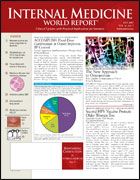Publication
Article
Internal Medicine World Report
First Vasodilating Beta-Blocker Improves Long-Term BP Control
Author(s):
By Wayne Kuznar
CHICAGO—A unique vasodilating beta-blocker, nebivolol (Mylan/Forest), currently under review by the FDA, effectively controls blood pressure (BP) over the long-term, and without many of the side effects associated with the first-generation beta-blockers, said presenters at the American Society of Hypertension annual meeting.
The lack of adverse metabolic changes with nebivolol makes it an attractive option for treating hypertension in obese patients.
Nebivolol improves endothelial function by enhancing nitric oxide release and therefore has the potential to slow atherosclerosis, said Vasilios Papademetriou, MD. In addition, nebivolol reduces systemic vascular resistance and increases stroke volume, unlike conventional, nonvasodilating beta-blockers, he said. The increase in cardiac output as a result of its vasodilating property results in less fatigue and erectile dysfunction compared with conventional beta-blockers.
Beta-blockers have been discredited as first-line treatment of hypertension because of their side-effect profile and a lack of efficacy in improving clinical outcomes compared with placebo in controlled clinical trials, said Dr Papademetriou, professor of medicine, Georgetown University, Washington, DC. In fact, European guidelines now recommend that beta-blockers not be used as first-line treatment for hypertension. These studies, however, were conducted with atenolol (Tenormin), a first-generation nonvasodilating beta-blocker, he noted.
"We need beta-blockers for many of our patients, because these agents slow heart rate, reduce oxygen demand, and decrease wall stress and shear forces," said Dr Papademetriou. "We're waiting for more data to see if nebivolol works the way we think it does."
He was lead investigator of a 9-month extension study that enrolled 845 patients with mild-to-moderate hypertension who previously completed 1 of 3 randomized, placebo-controlled, 12-week dose-ranging studies of nebivolol, 1.25 to 40.0 mg/day.
In the extension phase, patients were treated with open-label nebivolol, 5, 10, or 20 mg once daily. After 28 days, those who did not achieve an average sitting diastolic BP <90 mm Hg received open-label diuretics or amlodipine as adjuncts.
Average BP reduction at the end of 1 year in the 607 patients treated with nebivolol monotherapy was 14.8/15.0 mm Hg; 78.2% were considered responders to treatment. (Response was defined as a final trough sitting diastolic BP <90 mm Hg or an absolute decrease of ≥10 mm Hg from baseline of the "feeder" study.)
"These reductions in blood pressure indicate that nebivolol is as good as or better than other beta-blockers, or other agents for that matter," said Dr Papademetriou.
Among the 206 patients who also received a diuretic, average BP reduction was 16.2/12.0 mm Hg, and 65.5% were considered responders. Too few patients were treated with amlodipine or other add-ons for meaningful comparisons.
The incidence of fatigue was 4.6%, of dizziness was 3.0%, and of depression was 0.9%. Some 31 patients (3.7%) withdrew from the study because of adverse events; 26 in the nebivolol monotherapy group, 4 in the nebivolol plus diuretic group, and 1 in the group receiving nebivolol plus the calcium antagonist.
A post hoc pooled analysis of the three 12-week feeder trials also showed comparable BP reductions in obese and nonobese patients, reported James R. Sowers, MD, director, Center for Diabetes and Cardiovascular Health, University of Missouri, Columbia.
Of the 2016 patients enrolled, 878 were defined as obese (body mass index ≥30 kg/m2).
At the end of the study, baseline trough sitting diastolic BP declined by 7.7 mm Hg to 11.5 mm Hg (vs a 4.9mm Hg decline with placebo) in the nonobese patients, and from 6.7 mm Hg to 9.5 mm Hg (vs a 4.0-mm Hg decline) in the obese patients, a nonsignificant difference.





